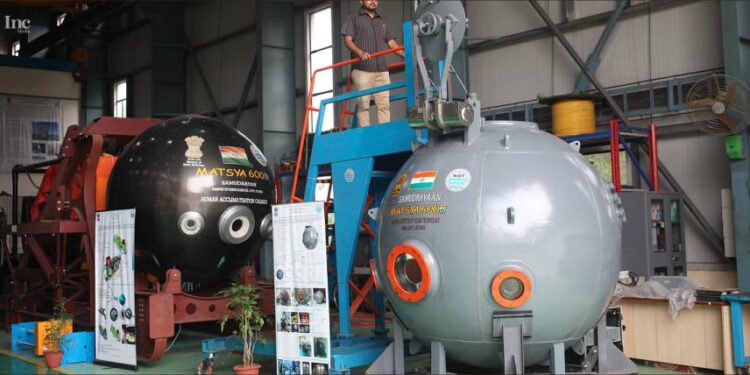India is taking the initiative to explore the universe through its indigenously built machines and space rockets. Recently, India has successfully landed its moon lander with an onboard rover, which is currently researching the moon’s surface.
Now the, India is set to launch its new scientific mission to deep sea exploration. The new submarine will be deployed to the Indian Ocean, where it will go about the deepest place in the sea to explore the region and conduct various science experiments.
The submarine named Matsya 6000 is a submersible designed to withstand high pressure in the deep sea. During the mission, various experiments will be conducted where photographic evidence and instrumental reading will be taken to check the habitat. It will help the scientist to improve their understanding of the deep sea.
Matsya 6000 submersible is built in India, where various teams work together to make this project successful. The government is pushing the science experiment highly to give the young youth direction for taking part in future science missions.
If we talk about the payload, it is carrying with it. The mission will have an individual who will travel 6000 meters underwater in the submarine.
Exploration will also focus on the finding of valuable such as metals and minerals. As per the scientists, there is a high possibility that we will find a massive deposit of cobalt, manganese, and nickel.
Scientists from the National Institute of Ocean Technology have been working on the project for several decades. Finally, the time has come when we will see real science taking place in our closest ocean to the country.
The team is conducting a compressive review of the submersible design, materials, and testing procedures with certification from the world’s reputed authority to ensure it follows all the standard methods to make the submersible more stable and ready to deal with high pressure. All the necessary procedures are double-checked using the standard operating procedure.
The M Ravichandran, who is a Secretary of the Ministry of Earth Sciences, said to TOI that the “Samudrayaan mission is underway and ready to launch soon; the team is conducting sea trials at the 500 meters depth, which begin in the first quarter of 2024.
A mission will run till 2026 before it will declared complete. The success of the deep sea mission will give new heights to India’s reputation in the science community. A handful of countries, including the US, Russia, Japan, France, and China, have successfully conducted the deep-sea mission in the past. Manned submersibles will be the first of its kind for India, sending the Indian explorer to a place no one has gone before.
Moreover, the mission will be focused on finding the earth metals and natural gas that may support India’s economy. Besides that, Indias Matsya 6000 will investigate the chemosynthetic biodiversity present in the Indian Ocean. There are possible low-temperature methane seeps in the sea.
Even though humans have landed on the moon, our oceans are still unexplored. Our earth occupies 75% of the land mass, but we need more information about it. Such a deep-sea mission will help us discover our ocean’s hidden secrets and give a new perspective to sea life.
The spherical shape of the submarine is a standard shape generally used for deep-sea missions. The share helps the material to withstand the immense pressure of the water above it. When the material reaches the deep sea, they are put under high pressure. Similar pressure is experienced by the military submarines.
For the Matsya 6000, scientists use a 2.1-meter diameter sphere, providing enough space for three individuals. The spare will be constructed using the 80mm thick titanium alloy. The titanium body creates a firm surface to withstand the high pressure under the deep sea.
Furthermore, the team has added the extra oxygen in the submarine to give a sufficient supply in an emergency. It is designed to operate continuously for about 12 to 16 hours in the deep sea. It will have about 96 hours of oxygen supply, so if anything goes wrong, the team will have sufficient time to pull the submarine back to the surface and save the person in it.
The submarine will be deployed through the ship, which hovers at the surface during the mission. It will track the progress at the location while helping the sub communicate effectively during the exploration mission with the ground team.















 The Inc Media is one of the most renowned global Online Business Magazines, that carries news stories about entrepreneurship, small business management, and business. Being a global business magazine, we carve for influential stories and try to take them globally to uplift the business standards and educate the people about new innovations in the business world...
The Inc Media is one of the most renowned global Online Business Magazines, that carries news stories about entrepreneurship, small business management, and business. Being a global business magazine, we carve for influential stories and try to take them globally to uplift the business standards and educate the people about new innovations in the business world...